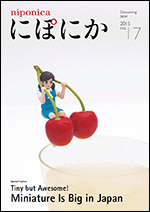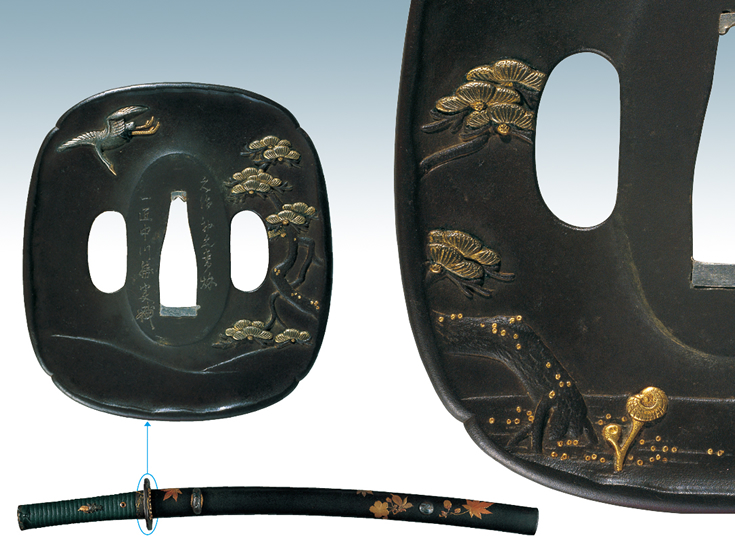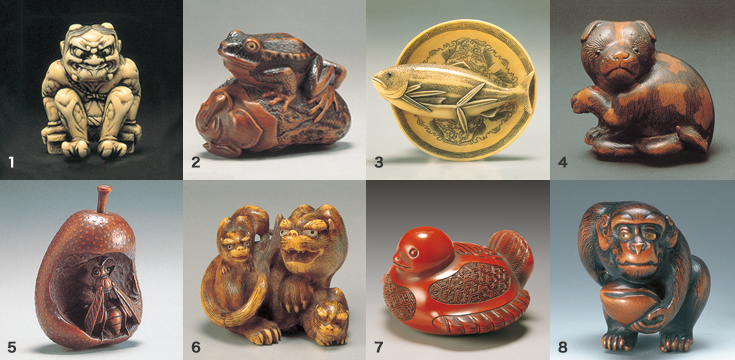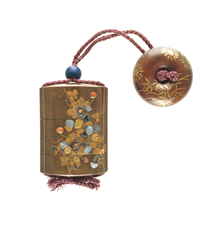niponica is a web magazine that introduces modern Japan to people all over the world.
2015 No.17

To read the e-book you need to have JavaScript enabled in your browser and a free Flash Player plug-in from Adobe Systems Inc. installed.
Miniature Is Big in Japan

The Traditional Decorative Arts of Japan, on a Minute Scale—
Magnificent and Meticulous
Arms for samurai, personal ornaments for common people, art exports to other countries...
A specialist in the history of Japanese industrial art and handcrafts explains this ancient world of meticulous decorative arts, honed to perfection by rival artisans whose techniques were the best of their time.
From a conversation with Kurokawa Hiroko
A look back at the history of Japanese art quickly takes you to renowned works made with precision techniques, whether for lacquer ware, metalwork or other works of art. But this kind of art was mainly found on objects used for devotional offerings to the gods and Buddhist saints, or luxury goods for aristocrats—items of culture for just a small group of people at the top of society. It was in the Edo period (1603-1867) that the common folk began to enjoy the achievements of sophisticated artistic techniques. It was a time of flourishing urban culture, when the world of decorative arts was expanding in diverse ways.
Perhaps the most impressive examples of the meticulous decorative arts of the Edo period are samurai sword parts. The end of the Warring States period had ushered in peace and tranquility, but the old practice of decorating swords lived on, remaining a symbol of samurai status. In fact, with times of peace, sword decoration evolved toward even more intricate detail. One example is the tsuba guard used to protect the hand on the sword hilt. The tsuba, hewn from a metal plate and measuring about 7 cm in diameter, featured delicate carving on both sides—masterful scenes of nature in an exquisite miniature world.


Tsuba guard to protect a samurai’s hand on his sword (see blue arrow, photo of sword in scabbard). Both sides of the guard are embossed in miniscule detail, depicting a pine tree and a crane. Object name: Sakura momiji makie wakizashi koshirae (“Tsuba Guard Decorated with Cherry Blossom and Maple Leaf”). End of 19th century. 6.2 x 6.9 cm. Property of the Nezu Museum.


Above are some humorous netsuke toggles depicting living creatures, characters from tales, etc.
1. Raijin, the god of thunder and lightning, gripping wooden footwear (geta clogs). Object name: Raiden (“Thunder and Lightning”). Carved ivory. Height 5 cm.
2. Frog depicted in graphic detail—for example, the tiny eyes are inlaid with the finely-crafted touch of a master. Object name: Hoshigaki ni kaeru (“Frog on a Dried Persimmon”). Made by Sukenaga. Carved Japanese box wood. Height 3 cm.
3. Depiction of a bonito fish to be eaten for the first time during the new season, a delicacy which was prized by the citizens of Edo. Object name: Kiba-bori hatsu-gatsuo netsuke (“First-of-the-Season Bonito as Carved Tusk Netsuke”). Made by Mitsuhiro. Carved ivory. Diameter 4.1 cm.
4. Small dog with one foreleg raised in a cute pose. Object name: Koinu (“Puppy”). Made by Sukenaga. Carved wood. Length 3.5 cm.
5. Pear peel and a bee, astoundingly true to life. Object name: Nashi ni hachi (“Pear with Bee”). Made by Kogetsu. Carved wood. Height 4.9 cm.
6. A mother tiger guards her two cubs with her sharp eyes. Object name: Oyako tora (“Mother and Cub Tigers”). Made by Hakuryu. Carved ivory. Length 3.5 cm.
7. Sparrow with feathers fluffed out to keep warm. A common motif at the time. Object name: Fukura suzume (“Bouffant Sparrow”) Lacquered. Length 4 cm.
8. Monkey holding a peach, which is a symbol expressing hope for a long life. Object name: Saru (“Monkey”). Made by Toyomasa. Carved wood. Height 3.7 cm.
Photos of all netsuke toggles taken from Netsuke: Gyoshukusareta Edobunka (“Netsuke: Edo Culture in Miniature”), compiled by the Japan Netsuke Academy and published by Bijutsu Shuppan-Sha Co., Ltd, 2005.
Techniques nurtured by fashion

Inro carrying case. Ivy illustrated in makie (gold or silver on lacquer) and raden (mother-of-pearl). The case has a round netsuke toggle also decorated with makie. Object name: Tsuta makie inro (“Ivy Makie Inro”). 6.8 x 4.9 cm. Property of the National Museum of Japanese History.
We must, of course, also remember the cultural world of kimono, and how it encouraged the development of other exquisite handcrafts. When worn, the kimono presents the viewer with long vertical lines. It is an excellent palette for patterns, but hardly lends itself to jewelry like a necklace or earrings. Kimono fashion adopted delightfully trendy styles in accessories like kanzashi hairpins for women, and sword-related objects for samurai—in other words, a blend of the practical and ornamental.
Inro are an excellent example. These were decorative accessories worn suspended from the waist. They were originally conceived as carrying cases for things like personal seals and medicine. The fashion trend was begun by samurai, but by the time the trend spread to commoners the inro was viewed simply as an accessory. They were rectangular in shape, generally around 9 cm high by 6 cm wide. The exterior was ornamented with illustrations or patterns using techniques such as makie (gold powder sprinkled on a lacquer design) or shippo (cloisonné enamel). Some motifs were inspired by objects from nature or fairy tales, some were auspicious patterns. Each minutely detailed design tells a unique story, and our eyes never tire of what they see.
Netsuke, another example, are small toggles used to hold things such as inro, kinchaku (cloth purses) and tobacco pouches suspended from the waist. The demand for netsuke as small personal ornaments also inspired the growing sophistication of manufacturing techniques. Generally modeled from wood or ivory, the designs were often humorous and exhibited exceptional skill, presenting a microcosm of nature on an object measuring only a few centimeters across. Netsuke are works of art depicting elements from the everyday culture of Edo in miniature.




